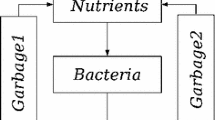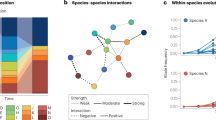Abstract
A spatially structured linear model of the growth of intestinal bacteria is analysed from two generational viewpoints. Firstly, the basic reproduction number associated with the bacterial population, i.e. the expected number of daughter cells per bacterium, is given explicitly in terms of biological parameters. Secondly, an alternative quantity is introduced based on the number of bacteria produced within the intestine by one bacterium originally in the external media. The latter depends on the parameters in a simpler way and provides more biological insight than the standard reproduction number, allowing the design of experimental procedures. Both quantities coincide and are equal to one at the extinction threshold, below which the bacterial population becomes extinct. Optimal values of both reproduction numbers are derived assuming parameter trade-offs.

Similar content being viewed by others
References
Bacaër N, Guernaoui S (2006) The epidemic threshold of vector-borne diseases with seasonality. The case of cutaneous leishmaniasis in Chichaoua, Morocco. J Math Biol 53(3):421–436
Barril C, Calsina A (2017) Stability analysis of an enteropathogen population growing within a heterogeneous group of animals. Discrec Contin Dyn Sys B 70(4):1231–1252
Boldin B (2008) Persistence and spread of gastro-intestinal infections: the case of enterotoxigenic Escherichia coli in piglets. Bull Math Biol 70(7):2077–2101
Calsina A, Palmada JM, Ripoll J (2011) Optimal latent period in a bacteriophage population model structured by infection-age. Math Models Methods Appl Sci 21(4):693–718
Calsina A, Diekmann O, Farkas JZ (2016) Structured populations with distributed recruitment: from PDE to delay formulation. Math Models Methods Appl Sci 39:5175–5191
Cortez MH (2013) When does pathogen evolution maximize the basic reproductive number in well-mixed host-pathogen systems? J Math Biol 67:1533–1583
Cushing JM, Diekmann O (2016) The many guises of \(R_0\) (a didactic note). J Theor Biol 404:295–302
Diekmann O, Heesterbeek JAP, Metz JAJ (1990) On the definition and the computation of the basic reproduction ratio \(R_0\) in models for infectious diseases in heterogeneous populations. J Math Biol 28(4):365–382
Dublin LI, Lotka AJ (1925) On the true rate of natural increase. J Am Stat Assoc 20:305–339
Engel K-J, Nagel R (2006) A short course on operator semigroups. Springer, Berlin
Geritz SAH, Kisdi E, Meszena G, Metz JAJ (1998) Evolutionarily singular strategies and the adaptive growth and branching of the evolutionary tree. Evolut Ecol 12:35–57
Heesterbeek JAP (2002) A brief history of \(R_0\) and a recipe for its calculation. Acta Biotheor 50:189–204
Inaba H (2012) On a new perspective of the basic reproduction number in heterogeneous environments. J Math Biol 65(2):309–348
Inaba H (2017) Age-structured population dynamics in demography and epidemiology. Springer, Berlin
Messenger SL, Molineux IJ, Bull JJ (1999) Virulence evolution in a virus obeys a trade-off. Proc R Soc B Biol Sci 266:397–404
Pugliese A (2002) On the evolutionary coexistence of parasite strains. Math Biosci 177:355–375
Schaefer HH (1974) Banach lattices and positive operators. Springer, Berlin
Thieme H (2009) Spectral bound and reproduction number for infinite-dimensional population structure and time heterogeneity. SIAM J Appl Math 70(1):188–211
Van Den Driessche P, Watmough J (2002) Reproduction numbers and sub-threshold endemic equilibria for compartmental models of disease transmission. Math Biosci 180:29–48
Webb GF (1985) Theory of nonlinear age-dependent population dynamics. Marcel Dekker, New York
Acknowledgements
This work has been partially supported by the coordinated Projects MTM2014-52402-C3-2 and MTM2014-52402-C3-3 of the Spanish government. JR is also partially supported by the project MPCUdG2016/047 of the University of Girona and CB by the Spanish Ministry of Education Grant FPU13/04333.
Author information
Authors and Affiliations
Corresponding author
Rights and permissions
About this article
Cite this article
Barril, C., Calsina, À. & Ripoll, J. On the Reproduction Number of a Gut Microbiota Model. Bull Math Biol 79, 2727–2746 (2017). https://doi.org/10.1007/s11538-017-0352-8
Received:
Accepted:
Published:
Issue Date:
DOI: https://doi.org/10.1007/s11538-017-0352-8




